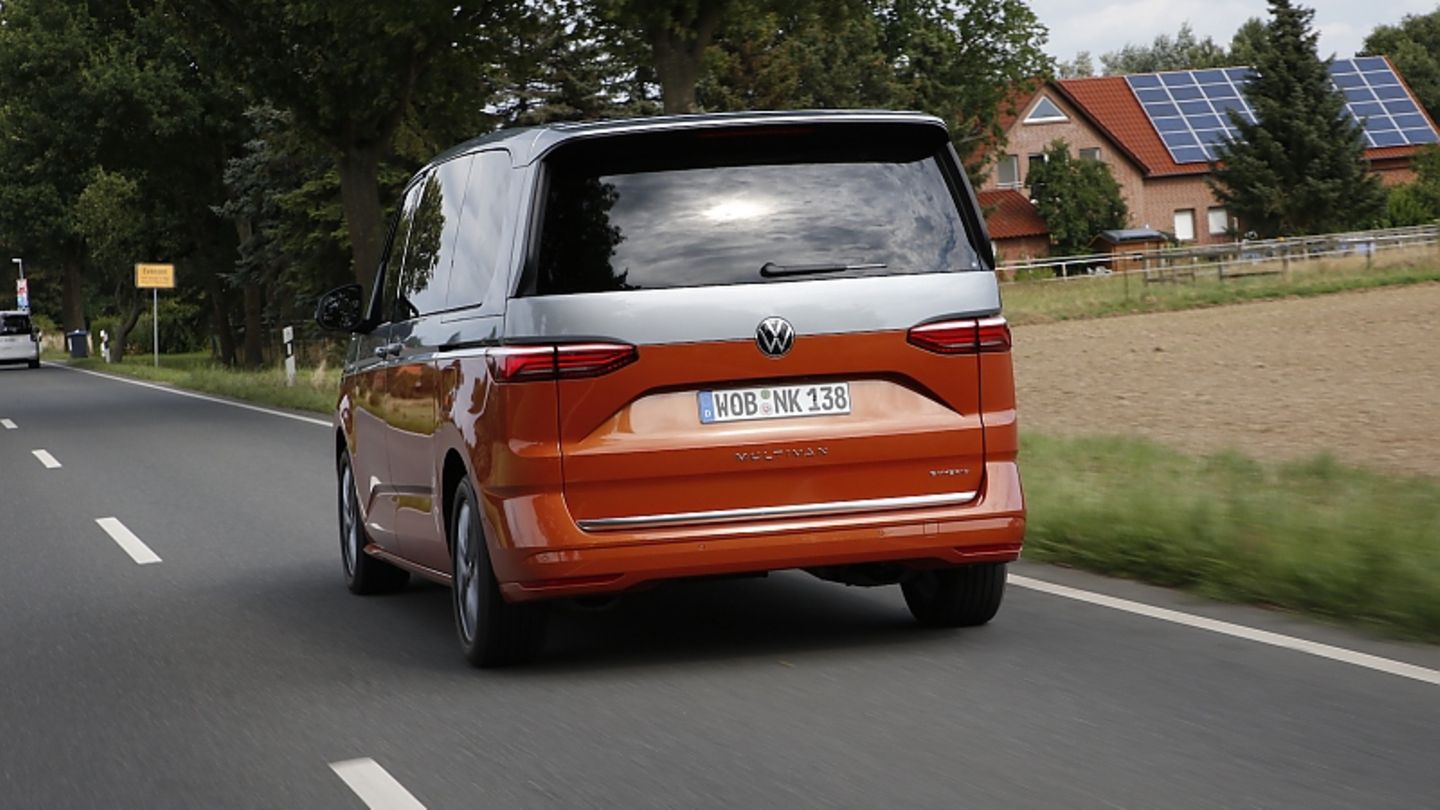With the new T7 Transporter, Volkswagen is switching to the current MQB platform from Golf, Passat and Co. We tested whether the switch to car technology would make the T7 better than ever.
The Volkswagen Transporter has been a bestseller for decades and has long been much more than just a commercial vehicle. Shopping carts, motorhomes, day care centers on wheels, moving wagons or business rooms – the possible applications know hardly any borders across borders. However, while the Volkswagen transporter was always a packhorse in development and was rededicated as a family-run passenger transporter, things are different for the first time with the new generation. With the switch to the MQB modular system, the T7 will be more variable and comfortable than ever from autumn this year. The aim is to increase the gap to the Mercedes V-Class, because that had hit the Lower Saxony a lot in the current generation. Unfortunately, there is a problem with the drives, because many customers will look around here when they look at the new T7 order lists. Powerful diesels have disappeared and there is no all-wheel drive for the time being. In a completely surprising way, Volkswagen relies on gasoline engines and a plug-in drive for such a van. After all, in two years’ time, with an electric rear axle, it should also become an all-wheel drive. The cheers especially from Mercedes and the direct competitors can be heard as far as Hanover.
When it comes to prices, at least after adjusting for equipment, things are even going down. The basic version of the 100 kW / 136 PS strong VW T7 with normal wheelbase and 1.5 liter four-cylinder petrol starts as a 4.97 meter long Multivan at 44,839 euros, the better equipped T7 Life costs at least 49,000 euros. That is also the starting price for the only diesel that will not be refilled until spring 2022. 150 diesel hp with front-wheel drive are around 61,000 euros in the top Style equipment. Above it are the two more powerful petrol engines with and without electrical assistance. The 2.0 TSI with 150 kW / 204 PS costs between 50,000 and almost 61,000 euros, depending on the equipment. The 5.17 meter long XL version (with unchanged wheelbase) costs a further 1,862 euros and the front-wheel drive VW T7 plug-in hybrid with 160 kW / 218 hp costs at least 57,174 euros. There is no longer a successor to the current top model VW 6.1 Multivan Exclusive with its 204 hp four-wheel drive and dual clutch transmission for at least 83,000 euros. Interested parties would then have to switch to the identically motorized Caravelle of the previous generation.
Volkswagen T7 is flatter than its predecessor
Why is Volkswagen Commercial Vehicles now giving up this well-known diesel terrain? After all, around three quarters of all T6.1s are currently equipped with an efficient diesel engine. At least commercial customers can still order the previous VW T6.1 in its well-known portfolio and thus also with powerful diesel engines, all-wheel drive or the California version. By switching to the MQB modular system, Volkswagen wants to reduce production and development costs and now also bring the variability of the platform to supposed commercial vehicles. Diesel are on the sidelines and one wants to rely on electric drives within the group. However, this is not available for the VW T7 because this spectrum is from the VW ID. Buzz and the ID. Buzz Cargo to be covered. “Compared to its predecessor, the T7 has become five centimeters lower and we have a flat floor for all models,” emphasizes Lars Krause, Member of the Board of Sales, “which means that comfort and variability in the interior have been significantly improved.” Do you, and especially the individual seats, can now be removed and reinstalled in just a few simple steps. However, the chairs can no longer be rotated and there is no shade-giving blinds on the large panoramic roof.
The basic version of the T7 Multivan takes 469 liters of luggage behind the third row of seats up to roof height. When loaded to behind the second row of seats, the volume rises to 1,844 liters. If the full load volume is used up to the roof behind the first row of seats, the result is 3,672 liters. The corresponding dimensions for the extended body version are 763, 2,171 and 4,005 liters. The animated cockpit and controls are known from Golf or Arteon. The rear seats have been slimmed down to 23 to 29 kilograms, depending on the version, and can now also be heated thanks to a new rail system. It can be assumed that Volkswagen will soon also be offering particularly comfortable Captain Chairs with electrical adjustment, massage and air conditioning. Only available for an extra charge: electric operation of sliding doors and tailgate.
In addition to diesel engines, there is also no all-wheel drive
It is only unusual that the customers who have previously spent a lot of money on a well-equipped top model are now left out and will continue to drive their old T6 or switch to the competition. In addition to the 136 and 204 hp petrol engines, the plug-in hybrid drive in particular is supposed to do the job, which is already well known from the Golf, Passat and Co. But its 1.4 liter displacement with 110 kW / 150 hp is quite meager for a transporter weighing more than two tons. The electrical support with the 85 kW / 115 PS electric motor, which provides a total output of 160 kW / 218 PS and is fed by a 13 kWh battery in the underbody, has nothing to do with that. Because they only read on paper like the level of a high-torque diesel. As such a popular long-distance family all-purpose van, the T7 therefore fails for many loyal customers. On the other hand, shuttle services that cover short distances can look forward to it, because with an electric range of almost 50 kilometers, it can be driven almost noiselessly and, last but not least, is tax-favored. Thanks to the additional electric boost, the T7 has taken itself to a completely new level in terms of driving comfort thanks to the modular car kit. Hardly anything rumbles even on cracked slopes, although the suspension on the small gasoline engines works better than on the plug-in hybrids, which weigh well over two tons and where the front axle looks a bit bumpy.
When the new family car then rolls onto the markets in November after its public premiere at the IAA, there will be no diesel at all and many customers will also shake their heads about that. A diesel will only be available in the second quarter of 2022 and then only as a 150 hp front-wheel drive. Those responsible at VW Commercial Vehicles admit that the markets in the Alpine regions in particular are already rising to the barricade because there are no diesel engines and 4Motion drives. And that everyone can make friends with an additional electric rear axle from 2024 can be doubted. Not before 2026 – with the new legal Euro 7 requirements – the long-awaited 204 PS diesel will follow – currently still without the all-wheel drive option. Customers are less likely to be bothered by the fact that the manual gearshift has had its day. All T7 versions get a dual clutch transmission and a clear reference in the driver assistance systems.
The question that remains is whether Volkswagen Commercial Vehicles will not be adding more and adding more drive options in order to retain old customers and attract new ones, because in the medium term it should not stay with the around 25,000 vehicles produced per year. Without real all-wheel drive and strong diesels, you might find it difficult in some markets and, in particular, leave a lot of terrain to the strong Mercedes V-Class.
I am a 24-year-old writer and journalist who has been working in the news industry for the past two years. I write primarily about market news, so if you’re looking for insights into what’s going on in the stock market or economic indicators, you’ve come to the right place. I also dabble in writing articles on lifestyle trends and pop culture news.




